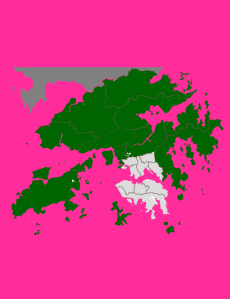BACKGROUND
The Small House Policy in Hong Kong’s New Territories poses a number of questions and demands regarding sustainability planning within ongoing village development.
Established as a British Colony in 1842, Hong Kong has become a Special Administrative Region (SAR) of the People’s Republic of China since its 1997 handover. The New Territories were the last territorial addition in 1898, following Hong Kong Island and Kowloon Peninsula. While there were recognized inhabitants throughout the Island and Kowloon prior to colonization by the British, historically, only the villagers situated in the New Territories were recognized as the “indigenous people of Hong Kong” with special rights to preserve their customs. When the sovereignty of Hong Kong was transferred from the United Kingdom to the People’s Republic of China over a century later, these special rights were preserved under Hong Kong Basic Law. Recognizing only established villages in the New Territories, today the special rights continue to be restricted to villages of the indigenous inhabitants.
THE SMALL HOUSE POLICY
The Small House Policy, introduced in 1972, is an administrative measure with the objective of improving the then-prevailing low standard of housing in the rural areas of the New Territories.
Under the Small House Policy, once in their lifetime any male indigenous villager, aged 18 or older proven to be descended through the male line from one of the recognized villages in the New Territories, is entitled to apply to build a “small house” of 700 square feet with a maximum height of three stories (i.e. a 2,100 square foot dwelling).
In order to protect the tradition of villages, indigenous inhabitants have the right to apply for a small house, commonly known in Cantonese as ting uk (literally “house of male”). Properties are only inherited, however, by male members of a village. As a part of their ding right, as it is called, the male villager applies for a free building license to construct a house on their own land with zero premiums, or a private treaty grant of Government land, if available, at a concessionary premium, within their village.
When this measure was established in the 1970s, the District Commissioner of New Territories had identified the Small House Policy as short-term:
“I do not see these measures (small house policy) as anything more than interim measures which will complement the major job of producing a comprehensive development plan for the rural New Territories.” – Dennis Bray, 1972 Speech to Legislative Council
That “major job” of a comprehensive development plan, however, was never fulfilled. Forty years later, the “interim measure” now threatens to create urban sprawl, according to urban planners, increasing potentially unmanageable expansion throughout the New Territories.
Since the handover in 1997, the enactment of basic law has upheld Article 40 which states: “The lawful traditional rights of interests of indigenous inhabitants of the ‘New Territories’ shall be protected by the Hong Kong Special Administrative Region.” As a result, indigenous villagers in the New Territories and their representative statutory advisory, the Heung Yee Kuk (literally “the Rural Council”), claim that this temporary administrative measure is a right extended to decedents of indigenous villagers forever protected by law.
No official tally exists of the number of indigenous village men who qualify but the Heung Yee Kuk estimates at least 240,000, and the number of names on the waiting list for small houses was estimated at more than 10 thousands in 2006. Each year the number grows without regard to the actual capacity to provide land and housing for every single applicant.
AWARENESS OF SOCIAL & ECONOMIC CONDITIONS
With changing social and economic conditions, the original justifications for the Small House Policy (SHP) have become dated according to urban planners, and there are various issues associated with its implementation. These include:
- Lack of fundamental sustainability – the SHP commitment is open-ended. Each year the number of eligible applicants grows as thousands of male villagers reach the age of 18. The area of land at present allocated for future small houses has been predicted to become fully utilized within 10 years’ time, possibly earlier.
- Discriminatory nature – the SHP may contravene the human rights instruments of the United Nations (UN) that apply to Hong Kong. The SHP has also been criticized by various UN Committees as discriminatory. While specifically exempted from the Sex Discrimination Ordinance, it certainly breaches the spirit of that ordinance. However, simply extending the SHP to women would be equally problematic and compound the issue of availability.
- Ways it can be and has been abused – the Audit Commission of the Hong Kong Government highlighted the problem of villagers selling their houses as soon as they are able to, thus cashing in on their eligibility for concessionary grants by hundreds of thousands of dollars and making the policy most vulnerable to corruption.
- Ad hoc planning – the lack of detailed layout plans encourages haphazard village development and suburban sprawl as a result of the SHP. Other major planning issues include: drainage and water quality problems, the availability of fire safety and emergency services, and logistical plans for parking and road expansion.
- Loss of traditional vernacular and character – another problem created by the SHP is that as villages become overgrown with houses and residents, the issues they face lead to heightened social stresses and unfortunate, preventable tragedy.
Ultimately, this list of changing social and economic conditions across the New Territories requires an in depth look at what the Small House Policy has caused within many villages. Designing Villages aims to create a greater awareness across Hong Kong of these problematic conditions, and proposes the need for more long term, viable and sustainable solutions.


